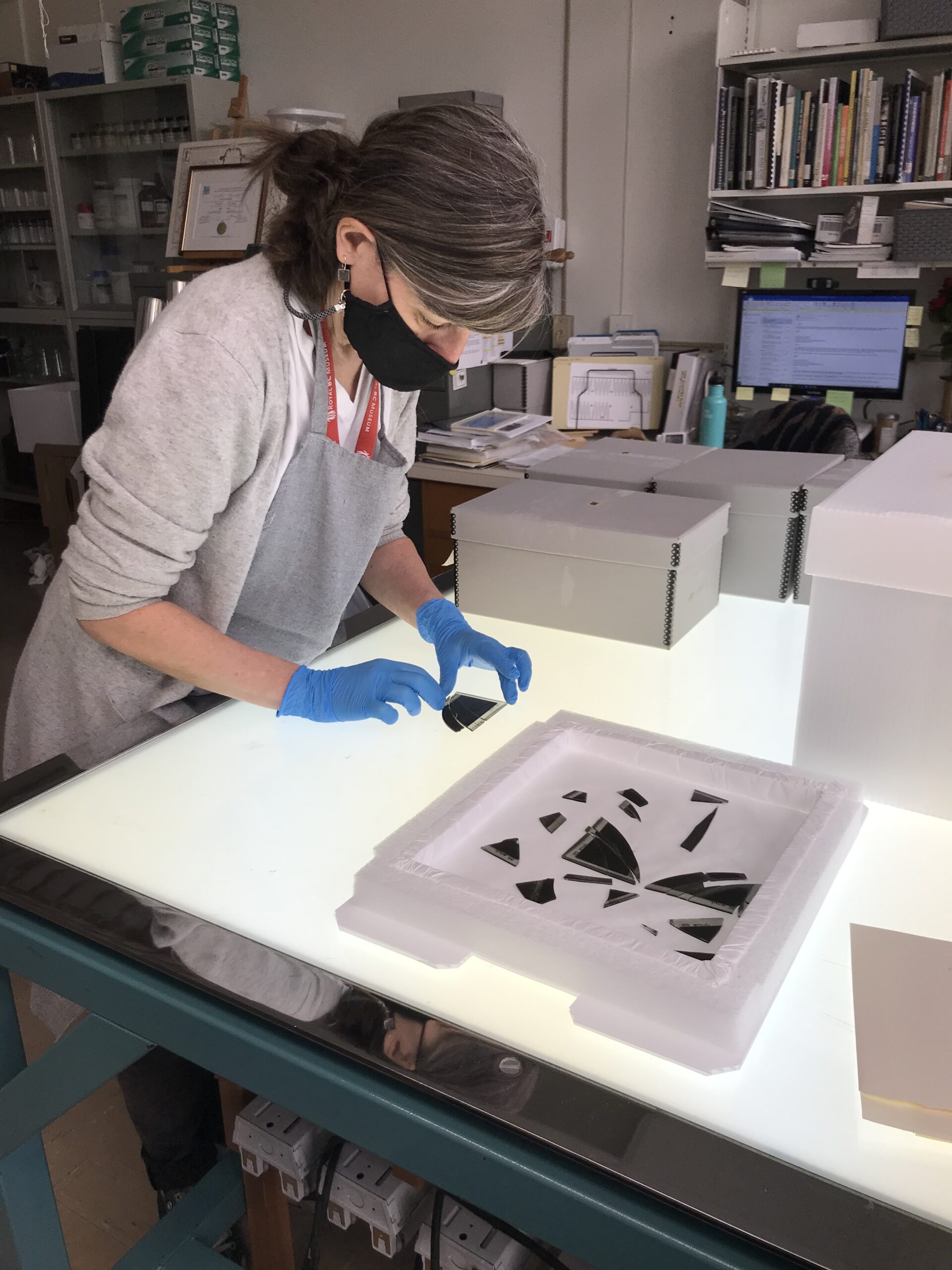The Royal BC Museum and BC Archives are preparing collections for a move to the new Collections and Research Building that will be constructed in Colwood in 2024 (see the announcement in Victoria News). This process involves surveying collections, re-housing items that may not currently be housed with enough protection for transportation outside of the storage areas and conserving artifacts and records that are not stable enough to be moved.
The Issue of Broken Glass Plates
One thing that has come through the Paper Conservation Lab a lot is broken glass-plate photographs. Glass plates were used as a support for photographic slides and negatives early in the history of photography and continued to be used well into the first half of the twentieth century. Many have undergone treatment in the past couple of years (see my previous blog post, Fragments of Glass: Repairing a WWI Glass Plate Negative), but these treatments are time-consuming. Too time-consuming for the size of the backlog measured against the staff resources currently available. This means that some plates may need to be moved prior to being treated. How do you move sharp, fragile shards of glass-plate photographs in a manner that keeps the plates and those handling them safe, while also maintaining the intellectual links these plates have to the rest of their respective collections?
The solution must account for plates of varying sizes that currently exist in two or more shards of varying sizes. All of the shards will need to be kept together so that pieces don’t get lost, and each shard should be secured in place to prevent shuffling during transit. Many broken plates are currently stored in envelopes. In these cases, the individual pieces have been permitted to grind up against each other and move around, creating an opportunity for the sharp edges of the glass to cut up the delicate photographic emulsion layer–a situation that would only become exacerbated by the vibrations associated with a move. It has also led to some shards becoming shuffled and mixed up.

Fig 3. Collection manager Vicky Karas using the transmitted-light table to sort through shards of glass plate negatives to reassemble broken plates preparation for rehousing
The Re-Housing Solution
To provide flexible yet sufficient support and protection for broken glass plates for the collection move, these broken plates are being moved into custom-made pincushion trays. The base of this
tray is Coroplast, a corrugated plastic board of archival quality. The edges are one-inch Ethafoam strips with a quarter-inch Ethafoam sheet in the center. The edges and inset surface of these trays are then lined with Tyvek to create a smooth surface for the plates. The Ethafoam is attached to the Coroplast with hot glue and the Tyvek is held in place without the use of any adhesives—it is pressed into the inner edge creases of the tray and under the edge strips, then folded up over the top edges of the tray and tucked into an incision that runs around the sunken portion of the tray.

Figure 4. Construction of pin-cushion tray
The glass-plate shards are set into the tray, one piece at a time, beginning in one of the tray corners. Each shard is held in place with a small block of Volara foam, which is then pinned in place with a one-inch stainless steel dressmaker’s pin. Once enough pins have been applied to hold this first shard in place, the next shard is added and held in place with more pinned foam blocks until all shards are pinned in place.
These trays are 26 cm x 23.5 cm in the centre, which means they can accommodate the majority of plate holdings. For smaller plates, two can fit in a tray. The external dimensions of the Coroplast base fit within a standard-size record storage box. The hand cut-outs on either side allow for the trays to lifted in and out easily and the one-inch Ethafoam edges provide support for subsequent trays when stacked within the box. Trays are numbered so that their position can be precisely noted and tracked while they remain separate from their original locations and replaced after treatment in the future. (Each tray also has an “a” side and a “b” side, to accommodate instances where there are two plates to a tray.)
The pincushion trays that have been created for this project will provide excellent protection for each shard as they move from one collections storage building to another and await conservation treatment. The downside of this new temporary storage system is that it drastically increases the amount of space these plates are taking up—and in the context of most archival and museum institutions, space comes at a high premium. In this instance however, the museum is moving to a new facility with larger collections stores, so the increase in the footprint of this collection is not a major concern. It is also a temporary storage system.
In the years to come, these plates will be treated and returned to their original storage locations as time permits, and these boxes of trays will not be needed. However, the flexibility of these pincushion trays means that if any new glass plates are acquired broken, there is an existing storage method available and already assembled to provide temporary protection and support while they await treatment.
Acknowledgements
I would like to extend a big thank you to Vicky Karas who has put a great deal of time, care and effort into this re-housing project already . . . and there’s still more to come.
Thank you to Lesley Golding, collections manager for the BC Archives photographic holdings, for her insight during the development of this temporary storage plan and her expertise in regards to location tracking and control.








